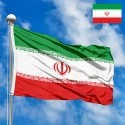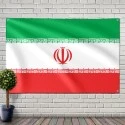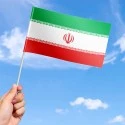The national flag of Iran is a deeply symbolic emblem that encapsulates the rich tapestry of the nation's ancient history, profound religious identity, and the revolutionary spirit that shaped its modern form. More than just a national identifier, it is a visual representation of the Islamic Republic of Iran's core principles, its struggles, and its aspirations. Adopted in 1980, after the Islamic Revolution, the current flag masterfully integrates traditional Persian colors with powerful Islamic and revolutionary motifs.
Design and Dimensions
The flag of Iran consists of three equal horizontal stripes of green, white, and red. The green stripe is at the top, the white stripe is in the middle, and the red stripe is at the bottom. This tri-color arrangement has historical roots in Persian vexillography, albeit with different interpretations and additional symbols over time.
In the center of the white stripe, the National Emblem of Iran (also known as the Emblem of the Islamic Republic of Iran) is prominently displayed in red. This emblem is a highly stylized composite of various Islamic and revolutionary symbols.
Along the bottom edge of the green stripe and the top edge of the red stripe, there are 11 repetitions of the phrase "Allahu Akbar" (God is the greatest) in Kufic script, making a total of 22 repetitions (11 on the green, 11 on the red). This specific number is significant, as the Islamic Revolution took place on the 22nd day of Bahman (11th month) in the Iranian calendar (February 11, 1979).
The official proportions of the Iranian flag are typically 4:7 (height to width), a less common ratio than the more standard 2:3, giving it a slightly elongated appearance.
Symbolism of the Colors and Elements
Each color and element on the Iranian flag is rich with deep symbolic meaning, reflecting the nation's cultural heritage, religious convictions, and revolutionary ideals:
-
Green Stripe: The top green stripe primarily symbolizes Islam, the predominant religion of Iran, and its commitment to Islamic values. It also represents growth, prosperity, and joy. Historically, green has been associated with the Prophet Muhammad and the Ahl al-Bayt (his household), making it a revered color in Islamic contexts. In the context of the Iranian flag, it signifies the country's fertile lands and its aspiration for development and progress.
-
White Stripe: The middle white stripe symbolizes peace, purity, and honesty. It represents the desire for a peaceful existence, both internally and in international relations. White is often associated with freedom and reconciliation, conveying the nation's hope for an era of justice and tranquility. Its central position in the flag emphasizes the importance of these virtues.
-
Red Stripe: The bottom red stripe symbolizes martyrdom, bravery, and sacrifice. It represents the blood shed by those who fought for Iran's independence and for the principles of the Islamic Revolution. This color denotes the nation's readiness to defend its sovereignty and values with courage and determination. It also carries connotations of fire and passion, reflecting the revolutionary fervor.
-
National Emblem (Allah): The red National Emblem in the center of the white stripe is a complex and highly significant symbol. It is a stylized representation of the word "Allah" (God) in Persian script. However, its design also incorporates several other layers of meaning:
-
Four Crescents and a Sword: The emblem is composed of four crescents and a sword. The four crescents can be interpreted as representing the growth of Islam, the five parts representing the five pillars of Islam, or the balance of the four natural elements (earth, air, fire, water). The sword in the middle symbolizes strength, justice, and the power of divine justice.
-
La ilaha illa Allah: The entire emblem is also designed to resemble the phrase "La ilaha illa Allah" (There is no god but God), the Shahada, the fundamental declaration of faith in Islam. This underscores the flag's profound religious dimension.
-
The World on God's Path: The emblem's circular form suggests the globe, indicating that the world is on the path of God, reflecting Iran's universalist aspirations in an Islamic context.
-
"Allahu Akbar" (Takbir): The 22 repetitions of "Allahu Akbar" (God is the greatest) in Kufic script along the borders of the white stripe with the green and red stripes hold immense historical and religious significance. This phrase, known as the Takbir, was chanted by the Iranian people during the Islamic Revolution (especially on the night of February 11, 1979, which was the 22nd of Bahman). Its presence on the flag serves as a perpetual reminder of the revolution's origins, its popular support, and the divine nature of its cause. The specific number 22 refers to the date of the revolution's victory.
History of Creation and Adoption
The history of the Iranian flag is a fascinating journey through centuries of Persian empires, monarchical rule, and ultimately, revolution. The tri-color scheme of green, white, and red has been present in various forms in Iranian flags for a long time, but their specific arrangement and the central emblem have undergone significant changes.
-
Ancient Persia and Safavid Empire: Ancient Persian empires used various banners, often featuring imperial symbols like the Derafsh Kaviani (a legendary royal standard) or animal motifs. During the Safavid Dynasty (1501-1736), the lion and sun motif became prominent, often on a green field.
-
Qajar Dynasty (1785-1925): Under the Qajar dynasty, the use of green, white, and red stripes became more formalized, often with the lion and sun emblem in the center. The lion and sun symbolized the ancient Persian monarchy and Islam.
-
Pahlavi Dynasty (1925-1979): The Pahlavi dynasty continued to use the green, white, and red horizontal stripes with the lion and sun emblem. However, the lion was depicted with a sword, and a crown was often placed above the sun. This flag, known as the "Lion and Sun Flag," was the national flag until the Islamic Revolution. It represented Iran's monarchical heritage and its long history as a nation.
-
The Islamic Revolution (1979): Following the overthrow of the Pahlavi monarchy and the establishment of the Islamic Republic in 1979, there was an urgent need to replace the symbols associated with the old regime. The existing green, white, and red stripes were retained, as they had a longer history in Persian vexillography and were not exclusively associated with the monarchy. However, the lion and sun emblem was removed, as it was seen as a symbol of monarchy and an un-Islamic icon by the revolutionaries.
-
Adoption of the Current Flag (1980): A competition was held to design a new national emblem that would represent the Islamic Republic. The winning design, created by artist Hamid Nadimi, was chosen for its profound Islamic and revolutionary symbolism. The current flag, incorporating this new emblem and the "Allahu Akbar" inscription, was officially adopted on July 29, 1980. This adoption marked the definitive visual identity of the new Islamic Republic, distancing it from its monarchical past and firmly rooting it in its new religious and political ideology.
Significance for the Inhabitants
For the people of Iran, the flag is a powerful and multifaceted symbol. It represents their Islamic identity and their adherence to the principles of the Islamic Revolution. The colors green, white, and red resonate with traditional Persian values, but their modern interpretation emphasizes religious piety, peace, and the sacrifices made for the nation.
The presence of the "Allahu Akbar" inscriptions is particularly significant, reminding citizens of the popular uprising that led to the establishment of the Islamic Republic and serving as a continuous declaration of faith. The emblem, as a stylized word for "Allah," reinforces the centrality of God and religion in the nation's governance and daily life. Despite varying political views, the flag generally commands respect as a symbol of the Iranian state and its sovereignty. It is a powerful reminder of their historical resilience and their commitment to an Islamic way of life.
Interesting Facts
-
The Lion and Sun: The previous national flag, featuring the lion and sun, had a history stretching back centuries and was one of the oldest national emblems in the world. Its removal after the revolution was a highly symbolic act.
-
Kufic Script: The use of Kufic script for "Allahu Akbar" is an ancient form of Arabic calligraphy, often associated with early Islamic texts and monumental inscriptions, lending an air of authenticity and historical depth to the flag.
-
The Number 22: The 22 repetitions of "Allahu Akbar" are a direct reference to the date of the Islamic Revolution's victory (22nd of Bahman). This specific detail provides a unique historical timestamp on the flag.
-
Unique Proportions: The 4:7 ratio of the Iranian flag is somewhat unusual compared to the more common 2:3 or 1:2 ratios seen in many other national flags, making it distinct.
-
Symbolic Balance: The arrangement of the "Allahu Akbar" phrases, bordering the white stripe, creates a visual balance and reinforces the idea of divine presence encompassing the core values of peace and purity.
-
Revolutionary Emblem: The current national emblem is one of the few in the world to be designed entirely from calligraphic elements, forming a stylized word rather than a traditional heraldic device.
-
Endurance of Colors: Despite profound political shifts, the green, white, and red tri-color scheme has remained a consistent feature of Iranian flags for centuries, demonstrating a deep-rooted cultural continuity.
-
International Recognition: The flag is widely recognized as the symbol of the Islamic Republic of Iran, representing its unique political and religious system on the global stage.
In the demonstration images, full-size flags are shown with proportions of 2:3, and hand-held flags with proportions of 1:2.









 Waving flag
Waving flag
 Sizes:
Sizes:
 Round flag
Round flag
 Sizes:
Sizes:
 Rectangular flag 2:3
Rectangular flag 2:3
 Sizes:
Sizes: